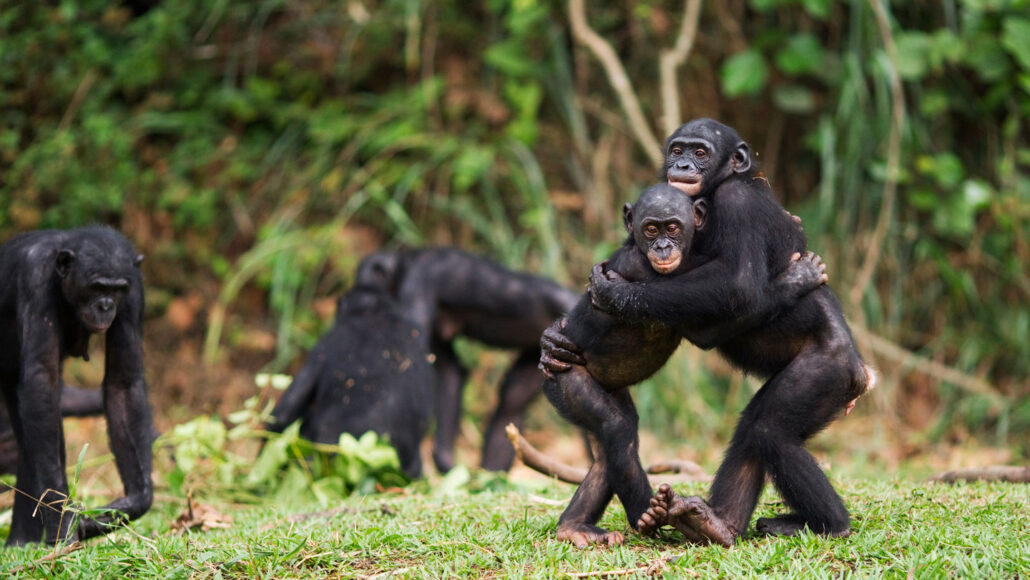Let’s learn about chimpanzees and bonobos
These apes may look similar, but they behave very differently

Bonobos (seen here) are a relatively peaceful species. These apes love to play games and show each other affection. Chimps look similar but have very different behaviors.
Anup Shah/Getty Images
In the animal family tree, chimpanzees and bonobos are our closest living cousins. About 6 million years ago, an ancestor ape species split into two groups. Humans evolved from one group. The other split into chimps and bonobos about 1 million years ago. Today, both ape species share about 98.7 percent of their DNA with humans.
Chimps and bonobos look a lot alike. Both have black hair. Both, unlike monkeys, lack tails. But bonobos tend to be smaller. And their faces are usually black, while chimp faces can be black or tan. Wild bonobos live only in the Democratic Republic of the Congo in Central Africa. Chimpanzees are found across Africa near the equator. Both species are endangered. People have hunted many of these apes and cut down the forests where they live.
Perhaps the most striking difference between chimps and bonobos is their behavior. Groups of bonobos are led by females and generally peaceful. They love to play silly games and show affection. And they’re often happy to groom and share food with bonobos they just met.
With chimps, it’s a different story. Groups of chimps are led by males and prone to fighting. These apes can be especially violent toward unfamiliar chimps. And they have to be tough to survive. They share their turf with gorillas. That means competing with those bigger apes for food and other resources. Bonobos don’t face that competition in their neck of the woods, so they can probably afford to be less aggressive.
Humans’ ape cousins are clever creatures. One chimp named Ayumu famously trounced humans at a memory game, while another named Washoe learned to use sign language. In captivity, both chimps and bonobos have been taught to communicate using lexigrams. Those are symbols that represent different words. Before learning to “speak,” chimps and bonobos use gestures to indicate what they want. Human children do the same thing. That may mean humans inherited this ability from the ancestor they share with chimps and bonobos. These and other discoveries about chimps and bonobos can teach us more about the human story.

Educators and Parents, Sign Up for The Cheat Sheet
Weekly updates to help you use Science News Explores in the learning environment
Thank you for signing up!
There was a problem signing you up.
Want to know more? We’ve got some stories to get you started:
Close cousins Find out the similarities and differences between humans’ two closest cousins, chimps and bonobos. (10/8/2013) Readability: 7.3
The ultimate genealogical search hunts for our earliest ancestors Scientists are uncovering the roots of the human family tree and finding out how we’re related to other species — living and extinct. (12/2/2021) Readability: 8.3
Chimp’s gift for numbers Meet Ayumu, a chimp who might have a condition known as synesthesia, which causes people to associate numbers and letters with colors. (7/5/2012) Readability: 8.3
Explore more
Explainer: Where and when did HIV begin?
What part of us knows right from wrong?
Many human ails are ‘scars’ of evolution
Cool Jobs: Getting in your head
Activities
The Chimp & See project invites volunteers to help analyze footage of chimpanzee habitats across Africa. By reporting their observations, volunteers offer new insight into chimp behavior. Because chimps descended from the same ancient ancestor as people, these apes could offer clues about how humans’ ancient relatives lived and evolved.







